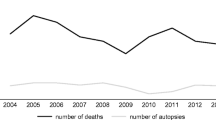Abstract
Objective: To examine the correlation between the clinical diagnosis and autopsy findings in adult patients who died in an intensive care unit (ICU). To determine the rate of agreement of the basic and terminal causes of death and the types of errors in order to improve quality control of future care. Design: Retrospective study. Setting: Adult ICU in a university hospital. Patients: 30 adult patients who died in the ICU, with the exclusion of medicolegal cases. Methods and main results: Anatomo-clinical meetings were held to analyze the pre- and postmortem correlations in 30 consecutive autopsies at the ICU of the University Hospital, School of Medicine of Botucatu/ UNESP, from January 1994 to January 1997. The rate of correct clinical diagnoses of the basic cause was 66.7 %; in 23.3 % of cases, if the correct diagnosis was made, management would have been different, as would have been the evolution of the patient's course (Class I error); in 10 % of the cases the error would not have led to a change in management (Class II error). The rate of correct clinical diagnoses of terminal cause was 80 %. Conclusions: The rate of recognition of the basic cause was 66.7 %, which is consistent with the literature, but the Class I error rate was higher than that reported in the literature.
Similar content being viewed by others
Author information
Authors and Affiliations
Additional information
Received: 15 May 1998 Accepted: 4 December 1998
Rights and permissions
About this article
Cite this article
Gut, A., Ferreira, A. & Montenegro, M. Autopsy: quality assurance in the ICU. Intensive Care Med 25, 360–363 (1999). https://doi.org/10.1007/s001340050858
Issue Date:
DOI: https://doi.org/10.1007/s001340050858




